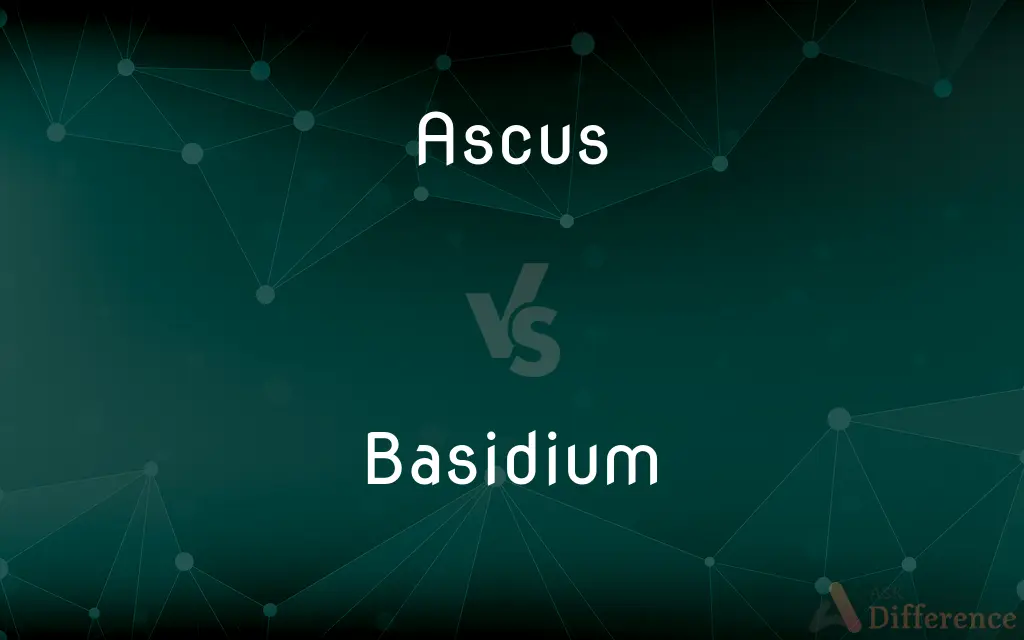Ascus vs. Basidium — What's the Difference?
Edited by Tayyaba Rehman — By Fiza Rafique — Updated on October 25, 2023
An "Ascus" is a sac in ascomycetes containing spores. A "Basidium" is a structure in basidiomycetes bearing sexual spores.

Difference Between Ascus and Basidium
Table of Contents
ADVERTISEMENT
Key Differences
"Ascus" and "Basidium" are both pivotal terms in the realm of mycology, specifically addressing the reproductive structures in fungi. An "Ascus" is the characteristic reproductive structure of fungi classified under the phylum Ascomycota. This sac-like structure houses the ascospores, which are the sexual spores in ascomycetes. Typically, an ascus contains eight ascospores, though variations can exist based on the species.
Conversely, "Basidium" is the reproductive structure characteristic of the phylum Basidiomycota. It's a microscopic, typically club-shaped structure that bears basidiospores, which are the sexual spores in basidiomycetes. The spores are generally situated externally on the basidium, usually at the tips of slender projections called sterigmata.
Further delineating the two, the development of spores in an "Ascus" is the result of a meiotic division followed, in most cases, by a mitotic division. This ensures genetic variability, a crucial component for the evolution and adaptability of species. In contrast, the "Basidium" undergoes meiosis to produce four haploid nuclei that migrate into four external projections, becoming basidiospores.
To encapsulate, while both "Ascus" and "Basidium" serve as reproductive structures in different fungal groups, they vary in terms of appearance, spore count, and developmental processes. These differences underscore the vast diversity and specialization observed in the fungal kingdom.
Comparison Chart
Associated Phylum
Ascomycota
Basidiomycota
ADVERTISEMENT
Structure
Sac-like
Typically club-shaped
Spore Location
Inside the sac
Externally on projections
Spore Development
Meiosis followed by mitosis
Meiosis
Typical Spore Count
Usually eight
Four
Compare with Definitions
Ascus
The sac-like structure in ascomycetes that contains ascospores.
The ascus of that fungus is filled with eight spores.
Basidium
A cell in which karyogamy occurs, leading to the production of basidiospores.
Following meiosis, the basidium gives rise to four distinct spores.
Ascus
A reproductive cell in certain fungi.
Under the microscope, you can observe the ascus and its internal spores.
Basidium
The site of sexual spore production in certain fungi.
Basidium plays a crucial role in the reproduction of many fungi.
Ascus
The sexual spore-bearing cell of ascomycetes.
The yeast's ascus revealed a typical eight-spore arrangement.
Basidium
The club-shaped reproductive structure of basidiomycetes.
The basidium of that fungus has four externally borne spores.
Ascus
The unit in which meiosis occurs in ascomycetes.
The formation of spores within the ascus is a result of both meiotic and mitotic divisions.
Basidium
A microscopic structure in basidiomycetes that bears basidiospores.
Mushrooms produce spores on a structure called a basidium.
Ascus
A membranous sac housing sexual spores in certain fungi.
Each ascus releases its spores when mature.
Basidium
A specialized fungal cell for external spore production.
Each basidium typically yields four spores attached to projections.
Ascus
An ascus (plural asci; from Greek ἀσκός ảskós 'skin bag') is the sexual spore-bearing cell produced in ascomycete fungi. Each ascus usually contains eight ascospores (or octad), produced by meiosis followed, in most species, by a mitotic cell division.
Basidium
A basidium (pl., basidia) is a microscopic sporangium (or spore-producing structure) found on the hymenophore of fruiting bodies of basidiomycete fungi which are also called tertiary mycelium, developed from secondary mycelium. Tertiary mycelium is highly coiled secondary mycelium, a dikaryon.
Ascus
A membranous, often club-shaped structure in ascomycetes in which karyogamy occurs, followed by the formation of eight haploid ascospores.
Basidium
A small, specialized club-shaped structure typically bearing four basidiospores at the tips of minute projections. The basidium is unique to basidiomycetes and distinguishes them from other kinds of fungi.
Ascus
(mycology) A sac-shaped cell present in ascomycete fungi; it is a reproductive cell in which meiosis and an additional cell division produce eight spores.
Basidium
(mycology) A small structure, shaped like a club, found in the Basidiomycota division of fungi, that bears four spores at the tips of small projections. 19
Ascus
A small membranous bladder or tube in which are inclosed the seedlike reproductive particles or sporules of lichens and certain fungi.
Basidium
A special oblong or pyriform cell, with slender branches, which bears the spores in that division of fungi called Basidiomycetes, of which the common mushroom is an example.
Ascus
Saclike structure in which ascospores are formed through sexual reproduction of ascomycetes
Basidium
A small club-shaped structure typically bearing four basidiospores at the ends of minute projections; unique to basidiomycetes
Common Curiosities
Is the "Ascus" a sexual or asexual structure?
The ascus is a sexual reproductive structure.
Which phylum is associated with the "Basidium"?
The phylum Basidiomycota is associated with the basidium.
Do both "Ascus" and "Basidium" undergo meiosis?
Yes, both structures undergo meiosis during spore formation.
How does a "Basidium" differ in shape from an "Ascus"?
A basidium is typically club-shaped, while an ascus is sac-like.
Which fungi have the "Ascus" structure?
Ascomycetes, under the phylum Ascomycota, have the ascus structure.
Are "Ascus" and "Basidium" both related to fungi?
Yes, both are reproductive structures in different groups of fungi.
Where are basidiospores located on the "Basidium"?
They are located externally, often on slender projections called sterigmata.
How many spores are typically found in an "Ascus"?
An ascus typically contains eight ascospores.
Are basidiospores produced inside the "Basidium"?
No, they are produced externally.
Are the spores in "Ascus" always sexual spores?
Yes, ascospores are the result of sexual reproduction in ascomycetes.
How are the spores in "Ascus" released?
They are often released when the ascus ruptures or breaks open.
Can one fungus have both "Ascus" and "Basidium" structures?
No, fungi either have asci (ascomycetes) or basidia (basidiomycetes), not both.
Do all basidiomycetes produce a visible mushroom?
No, not all basidiomycetes produce a visible fruiting body; some are microscopic.
Why are these structures important in mycology?
They are crucial for understanding fungal reproduction and classification.
How do spores from "Basidium" spread?
They are often dispersed by wind or other external factors.
Share Your Discovery

Previous Comparison
Appreciation vs. Acknowledgment
Next Comparison
Lamper vs. HamperAuthor Spotlight
Written by
Fiza RafiqueFiza Rafique is a skilled content writer at AskDifference.com, where she meticulously refines and enhances written pieces. Drawing from her vast editorial expertise, Fiza ensures clarity, accuracy, and precision in every article. Passionate about language, she continually seeks to elevate the quality of content for readers worldwide.
Edited by
Tayyaba RehmanTayyaba Rehman is a distinguished writer, currently serving as a primary contributor to askdifference.com. As a researcher in semantics and etymology, Tayyaba's passion for the complexity of languages and their distinctions has found a perfect home on the platform. Tayyaba delves into the intricacies of language, distinguishing between commonly confused words and phrases, thereby providing clarity for readers worldwide.














































